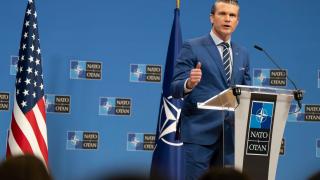War Hawks Panic as Trump Tears Up Ukraine Proxy War. But Will He Repeat Their Mistakes in Gaza?
By Stewart BattleFeb. 13, 2025 (EIRNS)—At the Feb. 12 Ukraine Contact Group meeting in Brussels, U.S. Secretary of Defense Pete Hegseth announced a new U.S. policy for Ukraine. He declared that there will be no NATO membership for Ukraine; any peacekeeping troops deployed there will not be under the umbrella of NATO or its Article 5; and the United States will not send troops to Ukraine. Further, returning Ukrainian territory it has lost since 2014 is “unrealistic,” Hegseth said. Panic immediately set in throughout NATO’s most hard-core faction, in Europe and in the U.S., among those who had hoped President Trump would maintain at least some degree of confrontation with Russia.
Trump capped off the day with a phone call to Russian President Putin, and set into motion what is rumored to be the first in-person meeting between the two leaders. When a reporter asked his opinion on whether Ukraine would be allowed to join NATO, Trump said he thought it was “impractical,” then went beyond that to acknowledge that Russia had legitimate interests which should be taken into consideration. “Long before President Putin, they [Russia] said there’s no way they’d allow that…. [T]hey’ve been saying that for a long time, that Ukraine cannot go into NATO—and I’m okay with that.” If this recognition becomes part of a future peace deal, it will fundamentally upgrade the desolate state of relations between the U.S. and Russia.
This, along with the confirmation of Tulsi Gabbard as the new Director of National Intelligence, will have substantial implications for the post-Cold War neoconservatives who had taken over nearly every corner of U.S. foreign policy. While their defeat is far from consolidated, and the nature of what Trump actually will do remains to be seen, this is certainly a positive development that has pulled the world back from the brink of thermonuclear annihilation. As Russian Foreign Minister Sergey Lavrov remarked on Feb. 12: “Two well-mannered men have just shown the world how politics should be done. I just hope that this will make those who have forgotten how it is done come to their senses, and re-read their history books as well as political science books.”
There was another important statement made on Feb. 12. White House Press Secretary Karoline Leavitt said, after summarizing the visit by Jordan’s King Abdullah II to Washington: “I would just add to that, that the President remains wholeheartedly committed to seeing peace in the Middle East. And our Arab partners in the region have been tasked with coming up with a peace plan to present to the President.” Whether that was an acknowledgment of the near-universal rejection of Trump’s radical “Riviera Plan,” it’s no mystery that a different proposal is needed, and fast. Egypt has reportedly been organizing other nations in the region around its own proposal, and is making plans for a major conference to be held at the end of the month on this subject. Other nations have weighed in heavily as well.
There were hopeful indications on Feb. 13 that the Israel-Hamas ceasefire deal would remain intact, and that hostages would continue to be released, while at the same time aid would finally flow to the desperate population in Gaza. But even so, this situation demands that a higher solution be found before the next tripwire throws the region back into full-blown war. The LaRouche Oasis Plan is vital in this regard.
Friday’s meeting of the International Peace Coalition on Feb. 14 will be a major point of intervention into this situation. The featured speaker will be Naledi Pandor, former Foreign Minister of South Africa, who will address this crisis as someone who has been a key participant—not only in the fight for a future for Palestinians, but also in the fight to develop brotherhood and sisterhood among humanity as a whole. That is what the LaRouche Oasis Plan for Southwest Asia represents, and is why it must urgently be promoted everywhere in the coming days.
It is incumbent on us to take the opportunities afforded by this shifting world—opportunities that have not existed for decades, or even centuries—and to establish a new security and development architecture, which is so badly needed.






